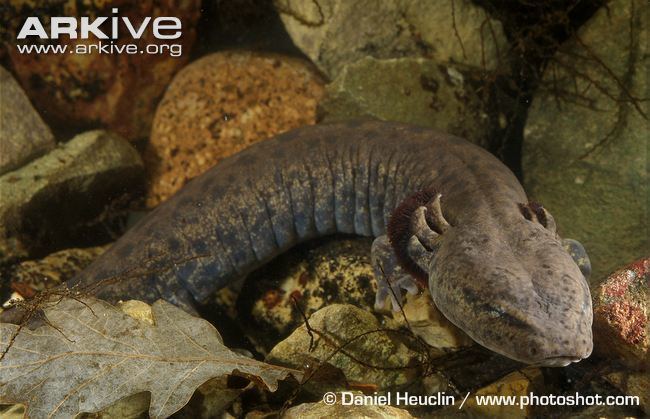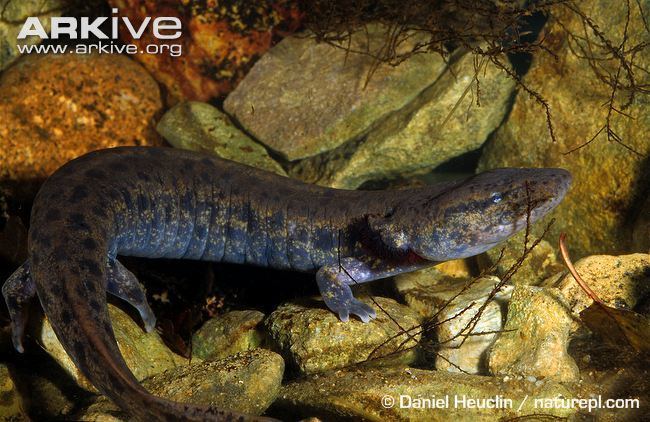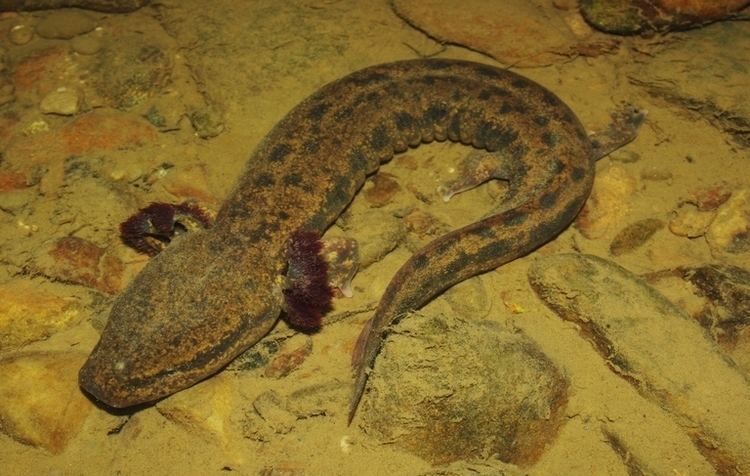Rank Species Order Caudata | Phylum Chordata Higher classification Necturus | |
 | ||
Similar Necturus, Salamander, Amphibians, Proteidae, Hellbender | ||
The common mudpuppy (Necturus maculosus) is a species of salamander in the genus Necturus. They live an entirely aquatic lifestyle in the eastern part of North America in lakes, rivers, and ponds. They go through paedomorphosis and retain their external gills, thus resembling axolotls. Because skin and lung respiration alone is not sufficient for gas exchange, mudpuppies must rely on external gills as their primary means of gas exchange. They are usually a rusty brown color and can grow to an average length of 33 cm (13 in). Mudpuppies are nocturnal creatures, and only come out during the day if the water in which they live is murky. Their diets consist of almost anything they can get in their mouths, including insects, earthworms, mollusks, and annelids. Once a female mudpuppy reaches sexual maturity, at six years of age, she can lay an average of 60 eggs. In the wild, the average lifespan of a mudpuppy is 11 years. Because of their prevalence and larger size than other salamanders, mudpuppies are good organisms for dissections.
Contents

Appearance

Mudpuppies can be a rusty brown color with gray and black and usually have blackish-blue spots, but some albino adults have been reported in Arkansas. In clear, light water, their skin gets darker, likewise in darker water, their skin gets lighter in color. At sexual maturity, mudpuppies can be 20 cm (8 in) long and continue to grow to an average length of 33 cm (13 in), though specimens up to 43.5 cm (17.1 in) have been reported. Their external gills resemble ostrich plumes and their size depends on the oxygen levels present in the water. In stagnant water, mudpuppies have larger gills, whereas in running streams where oxygen is more prevalent, they have smaller gills. The distal portions of the gills are very filamentous and contain many capillaries. Mudpuppies also have small, flattened limbs that can be used for slowly walking on the bottoms of streams or ponds, or they can be flattened against the body during short swimming spurts. They have mucous glands which provide a slimy protective coating, and granular glands that secrete poison used as defense against predators.
Distribution

N. maculosus specimens live in streams, lakes, and ponds in the eastern part of North America. They appear in the southern section of Canada, as far south as Georgia, and from the Midwest United States to North Carolina. In the more northern sections, they are called mudpuppies, and in the southern portions, they are called waterdogs. The mudpuppy hides under cover such as rocks and logs during the day and becomes more active at night. However, in muddy waters, the mudpuppy may become active during the day. Mudpuppies can even live under the ice when lakes freeze.
Diet

Mudpuppies use their two rows of teeth to eat their prey. At both sides of their mouths their lips interlock which allows them to use suction feeding. They are carnivorous creatures and will eat almost anything they can get in their mouths. Typically they prey upon animals such as insects, mollusks, annelids, small fish, amphibians, earthworms, and spiders. The mudpuppy has few predators but may include fish, crayfish, turtles, and water snakes. Because fishermen frequently catch and discard them, humans are considered to be one of their main predators.
Reproduction

Mudpuppies take six years to reach sexual maturity. Mating typically takes place in autumn, though eggs are not laid till much later. When males are ready to breed, their cloacae become swollen. Males deposit their spermatophores in the substratum of the environment. The female will then pick them up with her cloaca and store them in a small specialized gland, a spermatheca, until the eggs are fertilized. Females store the sperm until ovulation and internal fertilization take place, usually just prior to deposition in the spring. Before the eggs are deposited, male mudpuppies leave the nest. Once ready, the female deposits the eggs in a safe location, usually on the underside of a rock or log. They can lay from 20–200 eggs, usually an average of 60. The eggs are not pigmented and are about 5–6 mm in diameter. The female stays with her eggs during the incubation period (around 40 days). Hatchlings are about 2.5 cm long and grow to 3.6 cm before the yolk is completely consumed.
Subspecies

